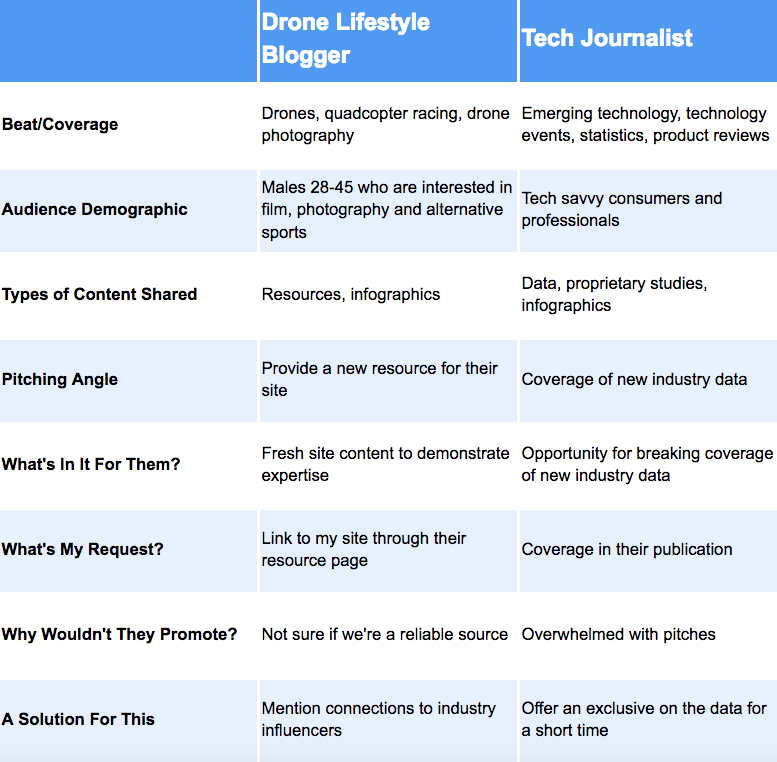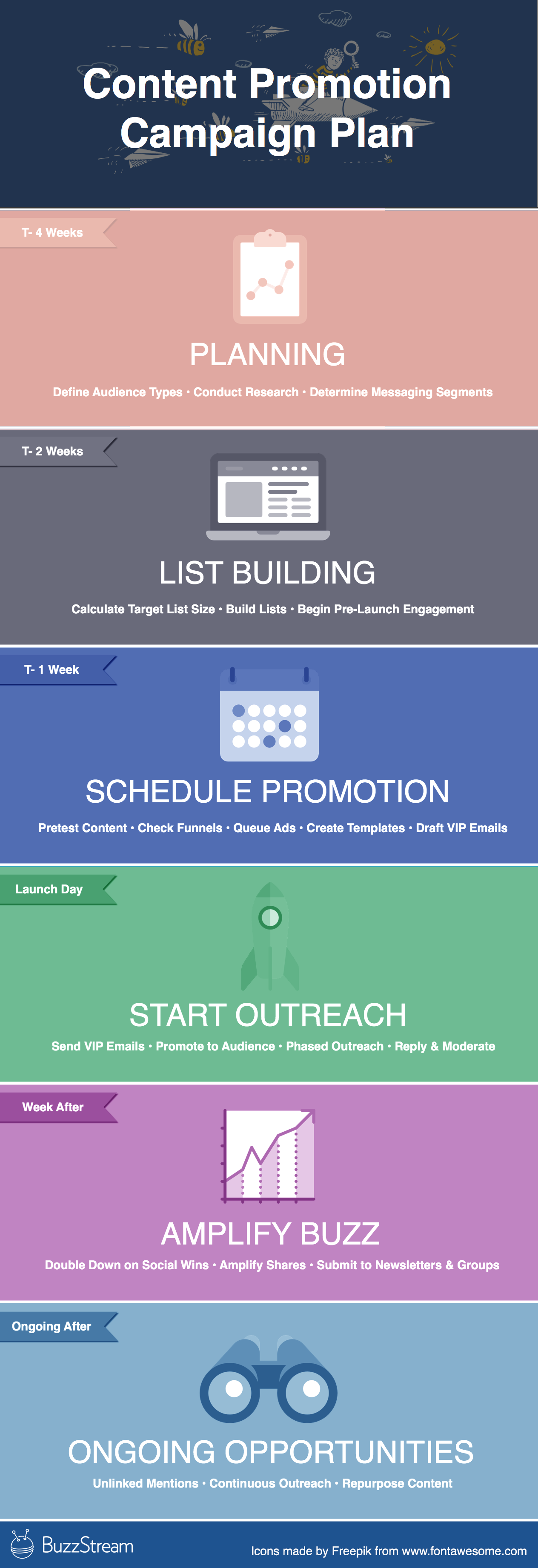Table of Contents

The original version of this post was written by the ridiculously talented Stephanie Briggs. Although it has been updated heavily it’s incredible how much of the original information still rings true. To keep up to date with her current goings-on, head over to Briggsby.
Many content marketers view “promotion” as a phase that begins once content goes live. The truth is, promotion should begin much earlier than that, running parallel to production, and most of the promotion work should be completed before launch.
Here’s a plan framework you can use for your next content campaign.
Planning

A good promotion plan begins with audience research and the development of targeted messaging. You’ll notice throughout this piece that the more effort you invest in intelligence and structure, the smoother and more effective the rest of your campaign will be.
Define Audience Types
There are multiple types of audiences that can potentially share your content.
The first is content collaborators, which can range anywhere from a partner helping create the content, to an influencer whose quote you’re including, to a respected member of a community you ask for feedback.
The second group are your bread and butter promoters. These are the journalists, bloggers, and business owners who will link or share to your piece.
Finally, you’ve got your amplifiers. They are the audience that will actually be reading your piece and sharing based on personal interest or to establish credibility in a field.
The type of audience you choose to engage will have a huge impact on timing (ie, if you want to collaborate with a major player you need to begin reaching out EARLY).
These audiences are also going to have wildly different goals and you need to determine those in order to send outreach with the right contextual triggers that will get them to work with you.
Conduct Research
Once you’ve determined the types of audiences you want to leverage for content promotion, you’ll need to break things down and do some research to determine what messaging will resonate.
At the end of your research, you’ll want to have a good idea of the following things:
- Topics and types of content that resonate with your target audience(s)
- The linking/sharing behavior of your outreach targets
- What you can offer of value that will get you the link or share from each segment
There are numerous ways to conduct this research.
If you are gathering data first-hand through surveys, interviews or proprietary data analysis you’ll want to alot at least a few weeks to get everything ironed out.
Of course, you don’t always have to be so formal.
For instance, at BuzzStream our planning stage usually involves a discussion of who we’re creating the content for and what their needs are. We use analytics data from previous pieces, information about what we’ve seen performing well on social, and insight from conversations we’ve had with customers to guide our content.
Once you’ve got enough data on your audience, you should try to segment your targets by the type of messaging and value delivery that will most resonate with them.
Determine Messaging Segments
Generally, groups that need to move fast will create unified messaging that will make sense for a large contact list, tweaking in minor ways as they go along. Paradoxically, this approach can actually increase the amount of time it takes to achieve your outreach goals, because generic messaging is usually unappealing.
Segmenting your communications is the best way to increase the response to your content promotion campaigns.
In order to get segmentation right, you’ll need to refer back to your audience research. In particular, you’ll need to make sure your messaging is contextually relevant and clearly demonstrates value.
Developing personas can be very useful here, particularly if you’re managing a large outreach team. I’d recommend you keep a shared doc and make note of the personas you’re targeting for each campaign, so teammates can refer back when they engage in similar future campaigns.
To show how segmentation can significantly impact outreach messaging, here’s a run through of different questions/criteria for two segments targeted for the same piece of content:

List Building

Your audience and persona development leads directly into list building.
List building can be a somewhat onerous and repetitive task. But I’d urge you to pay close attention during this step and make sure that you are adding prospects in an intelligent and methodical way, because getting your list right will make every aspect of your campaign run smoother.
The good news is that you’ve already got some solid research to guide you, so you should be able to know what makes a good prospect and communicate that to your team.
List Size
There are potentially limitless outreach prospects in the world with the right pitch and angle, so how do you know when you’ve got enough in your list?
You’ll want to refer back to your segmentation, because in reality you’ll almost always be better served by thinking in terms of building segmented outreach lists (plural).
First, consider your promotion goals. How many links/shares etc. do you need to make this campaign worthwhile?
Next, consider the general response/link/promotion rate of these segments. The best sources for this information are previous outreach campaigns you’ve sent to similar segments.
Once you’ve got that, you’ll divide your goal links by your success rate to get your target outreach list.
One last step that can give you a little bit more leeway (and should be considered critical if you are outsourcing list building or otherwise getting lists from people who aren’t directly familiar with your idea prospects) is to 5x your target list size.
This will mean more time spent vetting prospects, but will also get much closer to ensuring you hit your goal.

Pre-Launch Engagement
In some cases, you’ll get much better response rates from your prospects if you warm them up first before asking for anything.
It should be said that this will not always be the case. The most important elements of a successful outreach campaign are relevance and value for your prospect. Indeed, if your engagements come off as in any way self-serving or disingenuous then they can actually hurt you.
Particularly in the case of prospects that are busy or who have hundreds of requests made daily, you’re better off just getting to the point.
Still, there is a place for relationship building, particularly where such engagement is natural. One very solid approach is to reach out to anyone you’re linking to or referencing in your post to give them the opportunity to clarify the points you’re including or offer updated information.
For others, you’ll want to be more opportunistic. Put together Twitter and Feed.ly lists, get involved in the conversation on forums, and otherwise live where they live.
But please, don’t just mention them once on Twitter or leave a cursory blog comment. It’ll be obvious what you’re doing and will sour your chances of successful outreach.
Schedule Promotion

The week before you launch your content will likely be the busiest in your promotion cycle. Here’s where you shore up your lists, get buy-in from key influencers, schedule announcements and begin preliminary outreach.
Pretest Content
Pretesting content is a great way to get insight and buy-in from influencers and key audience members.
Essentially, during this step you want to get a preview of your content in front of people with relevant experience who can improve the information or even add to it.
In addition to making your content better and getting a sniff test from people who know what they’re talking about, you’ll also generate a sense of investment that will make those influencers more likely to share once the content goes live.
There are two approaches to doing this.
- The targeted approach – This path involves putting together a list of relevant influencers and reaching out directly for thoughts/feedback. If you go this route, you’ll effectively be doing a round of outreach before your content goes live. This obviously adds more complexity to your campaign, but even a few successes can expose your content to an expanded audience.
- The volunteer approach – This is much simpler. Just post to your social channels letting followers know that you’re about to release new content and you’re looking for reviewers. Obviously you have less control here but you can still get increased exposure and shares without dramatically increasing outreach costs.
Regardless of which approach you take, make sure you give influencers/audience members enough time to actually provide feedback.
Check Site Funnels
You’ve got influencers to share your content, traffic coming in from relevant audiences, readers who are engaging with the piece…
…and then what?
Nothing is more disheartening than a piece of content that performs well but doesn’t result in conversions for your actual business goals.
Take some time to think through the next steps you want a visitor to take after they read your content.
Look for opportunities to embed downloadable content, insert strategic (not too annoying) pop ups, or guide through the content itself to a conversion.
Queue Ads and Paid Promotion
If you’re going to throw some advertising muscle behind your piece, now’s the time to get images and messaging put together for those.
You’ll also want to figure out your testing schedule for the networks you’re going to promote on and get any test variants in place.
Create Preliminary Outreach Templates
We’ve mentioned the importance of targeted messaging for each audience segment throughout this piece, now it’s time to bring it all together.
First, finalize the segments you are going to send to.
Then, create your templates highlighting the information you gathered. The main focus should be establishing relevance, demonstrating the direct value a contact will get from promoting your piece, and preliminarily addressing any objections.
Note that I don’t include personalization in that list. There are probably some edge cases to this, but as a general rule if your “personalization” is generalizable enough to include in a template through merge fields, it will be useless (or harmful) in your outreach.
Instead, leave space in your template to personalize on a genuine, one-off basis.
Finally, create at least one test variant for each template in your campaign. This will allow you to double down on more successful messaging during subsequent rounds of outreach.
Draft VIP Emails
Some of your audience segments will be made up of high authority publications and influencers that will greatly benefit from completely custom emails. This particularly applies if you’ve been engaging with them to build a relationship prior to outreach.
For all of those, you should create email drafts in advance. That way you won’t have to think through custom messaging on the day of launch with all of the chaos that entails, and will also ensure you get those VIP emails out quickly (usually you’ll want to send them first).

Start Outreach

Launch day is here, and all your hard work leading up to this point is about to be put to the test.
Now is where you’ll see the benefit of your prep. If you’ve taken the time to get all the moving pieces in place then you’ll be able to glide through your tasks and get your messaging out as smoothly as possible.
There will still be some chaos (there always is), but it’ll be chaos of the organized variety.
Send VIP Emails
The very first thing you’ll want to do once you set your content live, before even sharing on social or blasting your lists, is sending outreach to critical influencers. The reason for this is simple:
If you give influencers first access to the content (and let them know it) they will feel like they’re being treated preferentially and are more likely to promote.
This is where the benefit of having drafts ready to go comes in particularly handy, because you definitely don’t want much of a delay before making a general announcement.
Promote to Your Audience
After you send your critical outreach you’ll want to promote to your existing audiences to start kindling interest in your piece.
This includes sending emails to your opt-in mailing lists, scheduling posts on your social channels, paying to boost your social announcements if that makes sense, and otherwise spreading the word to people who explicitly want to hear from you.
Phased Outreach
Now it’s finally time to begin sending outreach to the majority of your list.
Although it is very tempting to send to everyone as quickly as possible, a better approach is to phase your outreach.
This means sending the relevant template variants to about a quarter of each of your segments. Give those sub-segments some time to respond (half a day should give you enough data to go on). Then, based on the response rate to each of your templates, send the winning variant to the remainder of the segment.
This approach is obviously more involved, and it’s certainly not perfect. In many cases you will not get what would generally be considered a “statistically relevant” sample given the short gap between sending the first and second phase of your outreach. However, even this limited information can result in dramatic differences in outreach response, and is almost always a worthwhile exercise.
Reply and Moderate
Once you’ve proactively promoted your content, you’ll want to set aside the rest of your day to respond to people who engage with you
This includes, but is not limited to:
- Moderating blog comments
- Responding to replies to your outreach
- Jumping in to the conversation on social
- Retweeting messages that praise or spark discussion around your content
- Replying to any questions your audience has
- Further amplifying content if you notice it getting posted on other networks
- Posting content that gets picked up or mentioned by publications
Essentially, give yourself the flexibility to be everywhere at once 🙂
Amplify Buzz

Well hey, you survived!
Although the frantic (hopefully successful) first day of launch is behind you, you’ve got to keep pushing to ensure the initial buzz around your content continues.
Double Down on Social Wins
If you post multiple times on different social channels on launch day you’ll almost certainly see some posts and messaging outperforming others.
Assuming that’s the case, you’ll want to give those successful posts a further boost and modify messaging across channels to reflect the elements that resonated most.
If you haven’t invested much in paid social, now’s a great time to do it since you’ve got the benefit of already knowing which posts will be successful without the early stage A/B test requirements.
On the other hand, if you’re noticing that you’re not getting much response on any of your posts, that’s a pretty clear sign that you need to introduce entirely new messaging.
Amplify Shares
Keep an eye on the conversation throughout the week, paying particular attention to shares or comments from influencers outside of your time zone or standard work hours.
Once you see new people joining into the conversation, schedule retweets/thanks to get traffic spokes and build social proof as well as relationships.
Submit Content to Newsletters and Groups
You can get some easy qualified traffic for your content by submitting it to community sites, email newsletters and weekly roundups.
Most community sites will have guidelines on self promotion, so look into those and make sure you have the right post ratio (your content vs. others) and are observing all rules. And of course, make sure you’re clearly communicating value and not being at all sales-y. You definitely don’t want to damage your reputation or get blacklisted from future posts in a prevalent community.
Ongoing Opportunities

Once things start calming down, there are still ways you can generate value from your content and get ongoing promotional benefit. This obviously includes continuing to monitor for and thank people who share your content, but you have many other opportunities as well.
Link Reclamation (Unlinked Mentions) Campaign
If your content was at all popular, there’s a good chance that people shared it ( or elements of it) without crediting you directly.
A link reclamation campaign will help you get links and shares for your work from people who are actively demonstrating interest.
There are many tools/processes to run a successful link reclamation campaign. You can even set alerts to monitor for opportunities on an ongoing basis. Rather than get into the full cycle here (it’s straightforward but there’s a decent amount to cover), I’d point you to Darren Kingman’s article on efficient link reclamation which gives a deep dive on the subject.
Continuous Outreach
If the first round of outreach ignites the fire, ongoing outreach is what’ll keep it stoked.
Essentially, you’ll just need to top up your list of relevant prospects following the same process outlined earlier, except this time you’ll be able to send outreach with the benefit of knowing what performs for sites in their niche.
You can schedule this process monthly or quarterly, or alternatively if you’re using BuzzStream you can use our prospecting searches function to get updated prospect recommendations on a regular basis.
Repurpose Your Content
Repurposing your content is the definition of low-hanging fruit, but doing so can exponentially increase it’s value.
Here are a few ideas to get started:
- Create a video that highlights the key points in your article
- Create a webinar with live Q&A
- Pull data or facts and create an infographic
- Convert the article into a downloadable guide or cheat sheet
- Use the article as the basis for a public speaking engagement
- Pull info from the article to answer HARO queries
- Respond to questions on Quora using article contents
Wrapping Up
After your promotion campaign draws to a close, spend some time reviewing metrics like shares, visits, and conversions. Call out things you’ll want to remember for next time.
Categorize and make notes on influencers that helped promote your content, that way your team can leverage those relationships moving forward and build a snowball effect in future campaigns.
You should also refer back to your original influencer lists. It’s likely that some people who you initially considered moderate tier 2 influencers proved to actually be tier 1 advocates. Reorganize the list based on the results of your campaign, so you can be better equipped to move into the next project.

What methods are you using to promote your content? Anything we missed or that you’d like to see explored further? Let us know in the comments or tweet us @BuzzStream and we’ll get on it!

 End-to-end outreach workflow
End-to-end outreach workflow



 Check out the BuzzStream Podcast
Check out the BuzzStream Podcast






12 comments
Great article Stephanie! Could you elaborate more on what you mean by “reclaim the link” when speaking about backlinks?
Hi Cameron,
There are a lot of opportunities where journalists/bloggers talk about a brand or piece of content or study but don’t include a link back to it. This is an easy win. I’ll reach out and say something like “Thanks for mentioning our content/brand/study, would you mind linking over to the [content] so it’s easy for readers to find?”
Technically it’s claiming a link for the first time (and not re-claiming it), but that’s the standard term that people tend to use for those types of opportunities. Does that help?
Thanks!
Another point worth noting is that sometimes you might have to go through paid channels to promote your content. This is what a lot of the bigger organisations tend to do particularly on social-media sites such as Twitter and Facebook.
Hi Tim,
Reaching out to writers after you’ve read something they’ve posted is a great way to build relationships and rapport. Good idea!
Stephanie
Hey Stephanie,
Amazing article… I’ve been neglecting the promotion part of my content marketing for such a long time.
And I’ve been neglecting the part of the promotion that happens BEFORE the content is published even longer!
I’ve started researching this stuff just recently and I think your post is brilliant!!
One other thing I would like to add here:
It would be much more effective and much less time consuming if you do all these outreach tactics naturally, and not just prior to writing a piece.
Once you read a new article, you can comment on it and reach out to the author just for the sake of it. Then.. in case you’ll be writing your own piece about it, you will already have a small connection waiting to be expanded.
How does that sound? 😉
Hi Stephanie. Really great post. Outreach is something I struggle with, as I am much better at the actual story and content creation than I am sharing it, so I truly appreciate your tips.
For ongoing opportunities, I think you will find Mention.com helpful. It catches a lot of mentions and opportunities that Twitter and Google Alerts together does not. Would love for you to give it a try and let us know what you think. Look forward to your feedback.
Thanks again!
Shannon
A brilliant post. It seems like it would radically change the way we promote our content.
Thanks Stephanie.
Hi Helen,
I don’t currently have anything planned, but that’s a great idea. I’ll see what I can do. Thanks!
Thanks!
Stephanie, this is really interesting and full of fresh ideas article, but I am more interested in the Measure Results section which is pretty short. Do you plan to write more about it in the near future? Thanks, Helen
I’m glad you found it useful! Thanks for the kind words 🙂
Great resource. Will be sharing this with some of my clients for sure!
This is a pretty awesome. Thanks guys!